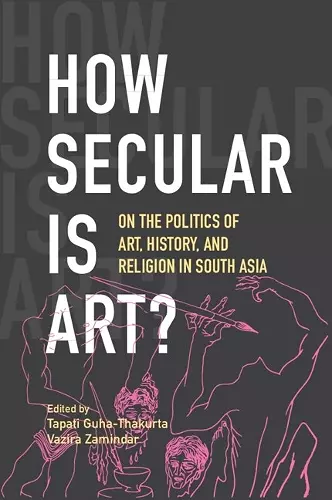How Secular Is Art?
On the Politics of Art, History and Religion in South Asia
Tapati Guha-Thakurta editor Vazira Zamindar editor
Format:Paperback
Publisher:Cambridge University Press
Published:27th Jun '24
Currently unavailable, and unfortunately no date known when it will be back

The book unravels the complex relationship between the modern categories of art, religion and secularism in contemporary South Asia.
Exploring the secular credentials and religious redesignations of art, this book is anchored in a conception of a region. Fissured by partitions, state-formations and religious nationalisms, this idea of a region still stands here as a collective site for interrogating the secularity of art, its histories and its politics.As an invitation to interrogate the secular modality of art, the book unsettles both the categories of 'art' and 'secular' in their theoretical and historical implications It questions the temporal, spatial, and cultural binaries between the 'sacred' and the 'secular' that have shaped art historical scholarship as well as artistic practice. Thinking from the south, all the essays here are anchored in a conception of a region – one fissured by histories of partition, state formations, and religious nationalisms but still offering a collective site from which to speak to the disciplines of art and the knowledge worlds in which they are embedded. The book asks: How do we complicate the religious designations of pre-modern art and architecture and the new forms of their resurgence in contemporary iconographies and monuments? How do we re-conceptualize the public and the political, as fiery contestations and new curatorial practices reconfigure the meaning of art in the proliferating spaces of museums, galleries, biennales and festivals? How do we understand South Asian art's deep entanglements with the politics of the present?
'Abandoning conventional analyses of secularism, dominated as they are by the language of law and politics, this superb volume of essays focusses instead on the practices and representations through which it is both manifested and debated in everyday life. In doing so it offers a fresh new approach to the secular as both idea and reality.' Faisal Devji, University of Oxford
'The question mark that hangs from the title of this volume, How Secular Is Art? summons the unsettled field of contestation surrounding secularism in South Asia that continues to torment the region. Bringing together interdisciplinary and cross-border perspectives and engaging with phenomena across the visual field-from festivals, exhibitions, monuments, and architecture to painting, art criticism, and contemporary art-this excellent collection of essays probes the profound ways that the crisis of secularism in South Asia has been uniquely played out in the realm of art and visual culture. It is a passionate, urgent, and timely intervention that raises many crucial questions for the future.' Saloni Mathur, University of California, Los Angeles
'The essays in this volume refresh our conceptions about political and religious art and their mutual relationships in exciting ways. Coming from diverse disciplinary affiliations, they look at iconic and street art, old and new monuments, secular and sectarian visual forms. As they suggest interconnections among several South Asian contexts, and their experiences of the visual and the political, they also enlarge our conceptual understandings of art and politics, faith, and protest. Above all, the essays, in their different ways, add significant new dimensions to long-standing debates and discourses about secularism and secularization. They explore secular-democratic movements against religious intolerance which, nonetheless, are represented within the visual signs and frames of sectarian piety and religious self-designation. By asking what such entanglement means for the various interpretations of secularism, they reconfigure our understanding of the cultural and political histories of contemporary South Asia.' Tanika Sarkar, Jawaharlal Nehru University, New Delhi
ISBN: 9781009380478
Dimensions: 229mm x 152mm x 25mm
Weight: 715g
444 pages